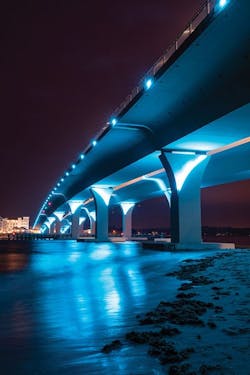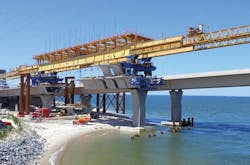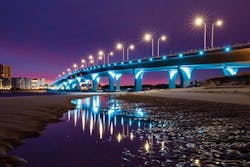NO. 4 BRIDGE: Lesner Bridge
Anyone traversing the area of the Lynnhaven Inlet along Virginia’s southern coast at nighttime would be remiss if they failed to notice the dazzling show of blue and white lights illuminating the Lesner Bridge.
The aesthetic lighting features served as the most appropriate finishing touch for the completion of the 1,575-ft dual-span structure which the surrounding community wanted to serve as a signature bridge—a gateway to Virginia Beach. The new segmental concrete bridge carries U.S. 60/Shore Drive traffic over the Lynnhaven Inlet and replaces the original John A. Lesner Bridge, which was classified as structurally deficient and functionally obsolete due to its location in a highly corrosive coastal environment in addition to the population growth experienced in coastal Virginia.
“We could not afford to have a bridge that’s been there for almost 50 years be subject to potential weight restrictions,” Christopher J. Wojtowicz, P.E., construction bureau manager with the Virginia Beach Department of Public Works, told Roads & Bridges. “We were doing annual bridge inspections, and we saw the sufficiency rating going down to a point where it was going to be very costly to do retrofits to the existing bridge.” The possibility of a new structure did not only provide the city with the opportunity to replace the bridge, but to also add pedestrian and bike accommodations across a new facility—improvements that would serve to enhance mobility in the region.
For the city of Virginia Beach, the bridge replacement project posed a number of challenges, from procuring funding to complete the extensive work required for the structure, working in such a highly corrosive coastal environment, and having to maintain zero reduction in traffic capacity throughout the duration of the bridge’s construction.
In the beginning stages of the project, the city had to engage with the Federal Highway Administration and the Virginia DOT (VDOT) to move forward in the planning process for construction. The city had decided early on that they wanted a segmental bridge in order to have longer spans, more curves on the structure, and an aesthetic quality that would fit the bridge into the landscape. One of the factors that was considered in the design phase of the project was to create more space between the pier columns in order to provide unobstructed views of the Chesapeake Bay and Lynnhaven River, since the current bridge had spacing of piles that were 50 ft apart, thus obscuring the views. A segmental bridge would lend itself to having wider pier column spacing.
This desire initially posed a problem with VDOT, as the agency had reservations about constructing a segmental bridge. “They were having problems with segmental bridges at the time, based on design flaws or means and methods of construction in the past, and it caused long-term maintenance costs for the state of Virginia,” Wojtowicz explained. The city of Virginia Beach was so adamant about getting the project off the ground without delay that it volunteered to pay for the engineering efforts. Over time, after the city continued to work with VDOT to show the structure would be durable, about $80 million eventually made its way from the governor’s transportation fund to support the project.
The highly corrosive coastal marine environment of the Lynnhaven Inlet presented a few concerns for the team in terms of the structure’s durability. “We’re in a tropical storm-hurricane environment—obviously a very aggressive chloride environment for steel in a bridge, so we wanted to make sure we used materials that were going to be durable enough to have a 100-year design life in the bridge,” Wojtowicz said. The bridge deck included corrosion-resistant reinforcing (CRR) steel and was post-tensioned longitudinally and transversely. The bridge deck also included a 4-in. final cover for long-term durability, and the substructure had a low-permeability concrete mix with CRR steel and an increased concrete cover of up to 6 in. at the bottom of footings.
In addition to challenging environmental conditions, concerns about environmental impact also affected the team’s approach to the project. While construction was carried out, a health and safety officer was tasked with watching for sea turtles so that the work would not impact any nests. The possibility of the endangered Atlantic sturgeon roaming the area also impacted construction methods, as the team specified drilled shafts instead of concrete piles to be driven in order to produce less vibration while installing so as not to disturb the sturgeon. The team also had restrictions on dredging in the Lynnhaven between October and February due to the winter flounder season.
The project was broken up into five phases in order to accommodate two lanes of traffic in each direction. “We had to maintain traffic at all times,” Wojtowicz said. “We couldn’t just reduce the traffic capacity because if we did, it would be an 18-mile detour [for motorists] from one side of the Lynnhaven Inlet to the other.” The first phase of the project removed the exterior beam of the existing westbound bridge, and the team shifted traffic over from that bridge to the existing eastbound lanes in order to make room for the new westbound bridge’s construction. Phase two allowed the team to begin construction of the new westbound bridge slightly to the north of the existing structures. Once the new westbound structure was complete, all traffic had to be shifted to that bridge; the westbound lanes were moved over to the new bridge, and work was done in the median to prepare that new westbound structure to temporarily handle eastbound traffic in phase three. Once that was finished and all traffic was on the new westbound bridge, phase four enabled the team to demolish the existing bridges and construct the new eastbound structure. The final phase shifted eastbound traffic onto the new eastbound structure, and the team was able to finish a 10-ft-wide multiuse path along the new bridge.
The new Lesner Bridge includes a 45-ft vertical clearance above mean high water and a 225-ft horizontal clearance at the navigational channel. Each bridge has two 12-ft travel lanes, 10-ft and 6-ft shoulders, and a 10-ft multiuse pathway—which is separated from the vehicular lanes by a blue-colored railing to fit the aesthetic theme as well as to provide pedestrian and cyclist protection. The four-lane divided roadway was designed to accommodate an additional lane in each direction if required in the future.
The aesthetic features and lighting designs along the bridge attract the attention of residents and tourists in the area. “People really love coming to the bridge—more than just crossing over the top, it becomes an experience sitting underneath the bridge and seeing the lights from the beach,” Wojtowicz said. “It’s very majestic looking from the beach, seeing these aesthetic lights. It makes an impression on folks that see it.”
The public reception just goes to show that Virginia Beach has successfully established its gateway into the city.


